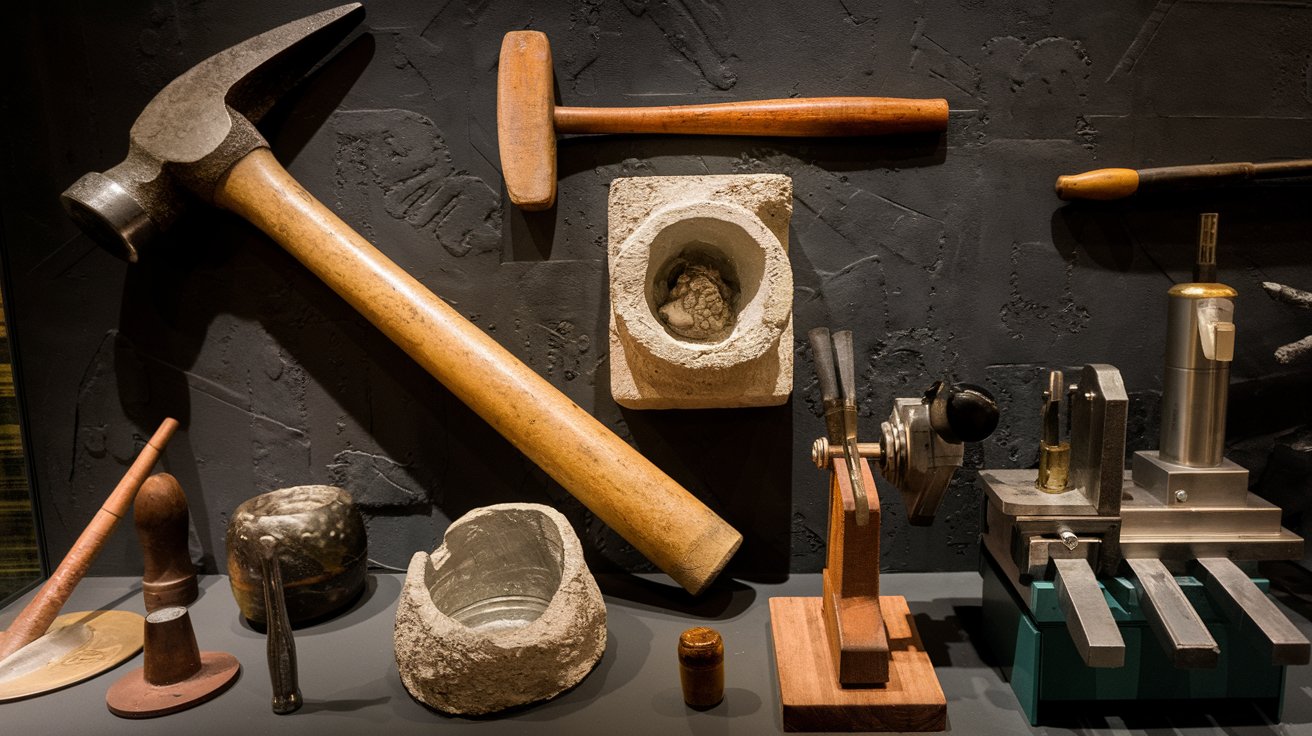
Metallurgy has shaped human civilization for over 6,500 years, transforming raw ores into useful metals and alloys. From the first discovery of native metals like gold, silver, and copper to the development of complex industrial processes, metallurgy has driven technological advancements and societal progress. Early civilizations used metals for tools, weapons, and ornaments, leading to significant cultural and economic impacts. The Iron Age marked a pivotal shift, with iron replacing bronze due to its superior strength. Today, metallurgy continues to evolve, with modern techniques allowing precise control over metal properties, fueling innovations in aerospace, medicine, and sustainable development.
Key Takeaways:
- Metallurgy, the ancient art of working with metals, dates back over 6,500 years. From the discovery of gold and copper to the modern aerospace applications, metallurgy has shaped our world in remarkable ways.
- The future of metallurgy holds exciting possibilities, from creating new alloys for digital devices and aerospace to improving medical implants and making nuclear waste disposal safer. The recyclability of metals also plays a crucial role in sustainable development.
The Dawn of Metallurgy
Metallurgy, the art and science of extracting and modifying metals, has a history that stretches back over 6,500 years. Let's explore some fascinating facts about its evolution.
-
First Known Metals: Gold, silver, and copper were the first metals discovered in their native state, often found in riverbeds.
-
Native Metals: Early humans used these metals for ornaments and tools during the latter part of the Stone Age. Gold could be shaped by cold hammering.
Copper and Bronze Ages
The discovery and use of copper and its alloys marked significant advancements in early metallurgy.
-
Copper Development: Around 8000 BCE, copper became the first widely used metal due to its softness, ductility, and low melting point.
-
Bronze Discovery: Bronze, an alloy of copper and tin, emerged around 3500 BCE. It was harder and more durable than copper, ideal for weapons and tools.
-
Bronze Production: Copper, arsenical copper, and tin bronze were produced together for some time. The decline of copper-arsenic alloys might be due to arsenic scarcity or poisoning concerns.
The Iron Age
Iron's introduction brought about significant changes in toolmaking and warfare.
-
Iron Age: Around 1200 BCE, iron began to replace bronze. Iron is harder and more durable but has a higher melting point, making it more challenging to work with.
-
Smelting Process: Smelting, heating ores to extract metals, was an early technique that allowed larger quantities of metal production.
Ancient Metallurgical Innovations
Early civilizations made remarkable advancements in metalworking techniques.
-
Middle Eastern Innovations: Around 4000 BCE, the Middle East saw the invention of the furnace and bellows, revolutionizing metalworking.
-
Ancient Egyptian Metallurgy: Egyptians used copper, gold, silver, and iron. They produced iconic objects like King Tutankhamun's golden mask.
-
Bronze Culture: The bronze culture spread from the Middle East to Egypt, Europe, and possibly China through trade and migration.
Alloy Development and Early Industry
The discovery of alloys and the establishment of early metalworking industries marked new milestones.
-
Ironworking Techniques: Ironworking evolved, leading to steel production, an alloy of iron and carbon.
-
Alloy Development: The discovery that metals could be mixed to form alloys like bronze, which had different properties than their ingredients.
-
Early Metalworking Industry: The first metalworking industry in the U.S. was established in Jamestown, Virginia, in 1608, producing essential tools and weapons.
Metalworking Art and Techniques
Metalworking requires a range of skills and techniques, from design to finishing.
-
Metalworking Art: This art demands precision in design, engineering, fabrication, and finishing to meet desired standards.
-
Prehistory Metalworking: Early metalworking involved making small items from copper ore, with wrought copper foil dating back to 2600-2400 BCE.
Significant Metallurgical Milestones
Throughout history, metallurgy has seen numerous significant milestones.
-
Gold Purification: Around 1500-30 BCE, techniques to extract gold from ores, often using mercury, were developed.
-
Iron Usage: Iron use began around 900 BCE-100 AD, initially for tools and weapons, leading to technological advancements.
-
Metal as Money: Around 540-500 BCE, metals like gold and silver were used as currency due to their durability and rarity.
-
Sword-Making: Metal for sword-making began around 700-800 AD, with advanced techniques for forging high-quality steel blades.
-
Cast Metal Weapons: The 15th century saw the development of cast metal weapons, allowing mass production of firearms and military equipment.
Modern Metallurgical Innovations
The modern era has brought about unprecedented advancements in metallurgy.
-
Tin Can Creation: In 1810, the tin can was created for food storage, revolutionizing food preservation and transport.
-
Aluminum Foil Production: Around 1910, aluminum foil production began, with applications in food packaging and medical equipment.
-
Titanium Aircraft Development: The 1950s saw the development of titanium aircraft, valued for its strength-to-weight ratio and corrosion resistance.
Ancient and Modern Metallurgical Techniques
From ancient techniques to modern innovations, metallurgy has continuously evolved.
-
Ancient Egyptian Iron Beads: Made from hammered meteoritic iron, these beads date back 5000 years, showcasing early iron use in jewelry.
-
Arsenic Bronze: This alloy, containing arsenic, copper, and tin, was used for its superior properties in tools and weapons.
-
Galvanization Process: Dipping iron into molten zinc to prevent rust, widely used in construction and automotive industries.
Industrial Revolution and Beyond
The Industrial Revolution marked a turning point in metallurgy, leading to modern advancements.
-
Industrial Revolution: New technologies like the Bessemer process made steel production cheaper and more efficient, leading to widespread use.
-
Modern Metallurgy: Evolved from an artisan craft to a large-scale industry, relying on cutting-edge science to control alloy composition and observe metal structures at the atomic level.
Future of Metallurgy
The future of metallurgy promises continued innovation and progress.
-
Material Invention: Over the past 200 years, new alloys have been developed to meet specific industry requirements.
-
Alloy Engineering: Modern metallurgists can engineer metallic microstructures for desired properties like high strength and corrosion resistance.
-
Digital Devices: Up to a third of the periodic table's elements are used in digital devices, advancing computing and communication technologies.
-
Aerospace Applications: New alloys are in high demand for aerospace, requiring materials that withstand heat and stress. SpaceX engineers superalloy steels for its Raptor Engines.
-
Medical Implants: New alloys enhance corrosion resistance and biocompatibility, improving the quality of life for patients with implants.
-
Nuclear Waste Disposal: Research on new alloys aims to make nuclear waste disposal safer, preventing radioactive material leakage.
-
Recyclability of Metals: Nearly all metals are recyclable, making them crucial for sustainable development. Metal fabrication has been around for centuries, and its recyclability is a key aspect of sustainability.
Metallurgy's Impact on Civilization
Metallurgy has shaped human civilization for over 6,500 years. From the discovery of native metals like gold, silver, and copper to the development of bronze and iron, each advancement brought significant changes. The smelting process allowed early societies to produce larger quantities of metal, leading to innovations in tools, weapons, and art. The Industrial Revolution marked a turning point with new technologies like the Bessemer process, making steel production cheaper and more efficient. Modern metallurgy now relies on cutting-edge science, enabling the creation of specialized alloys for industries like aerospace, automotive, and medical devices. The recyclability of metals also highlights their importance in sustainable development. Metallurgy's evolution continues to drive innovation, ensuring it remains a cornerstone of technological progress.
Frequently Asked Questions
Was this page helpful?
Our commitment to delivering trustworthy and engaging content is at the heart of what we do. Each fact on our site is contributed by real users like you, bringing a wealth of diverse insights and information. To ensure the highest standards of accuracy and reliability, our dedicated editors meticulously review each submission. This process guarantees that the facts we share are not only fascinating but also credible. Trust in our commitment to quality and authenticity as you explore and learn with us.


